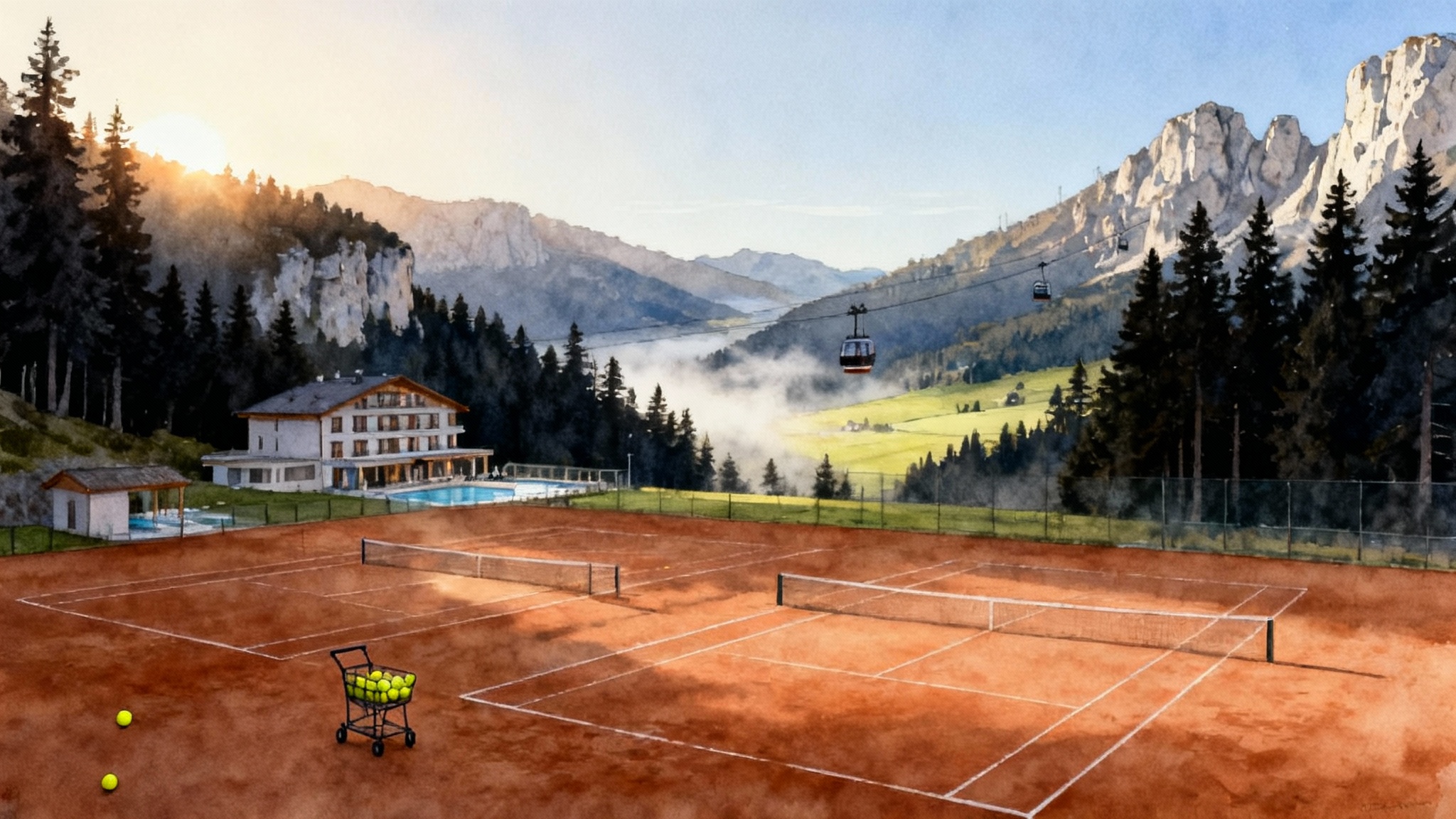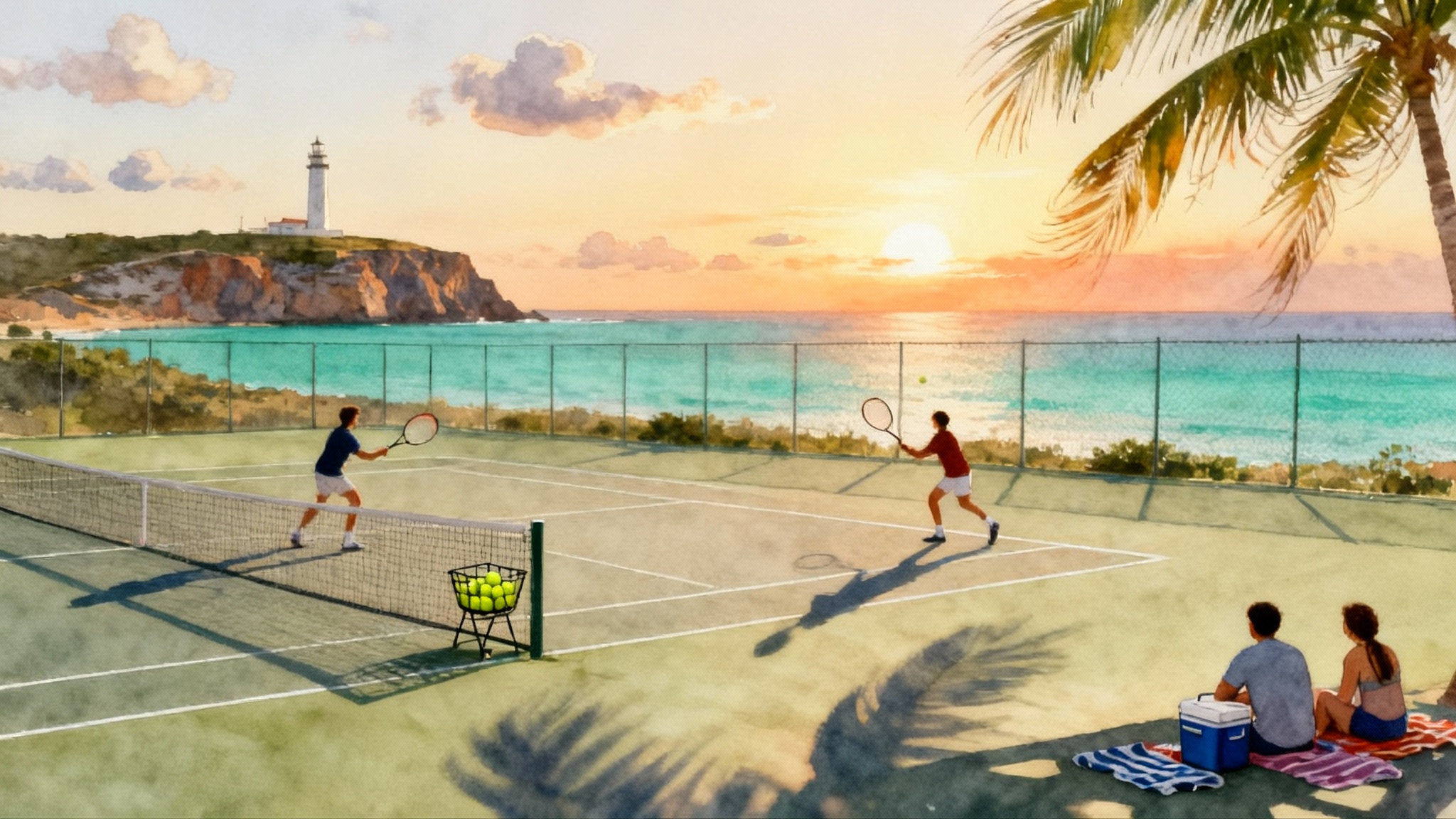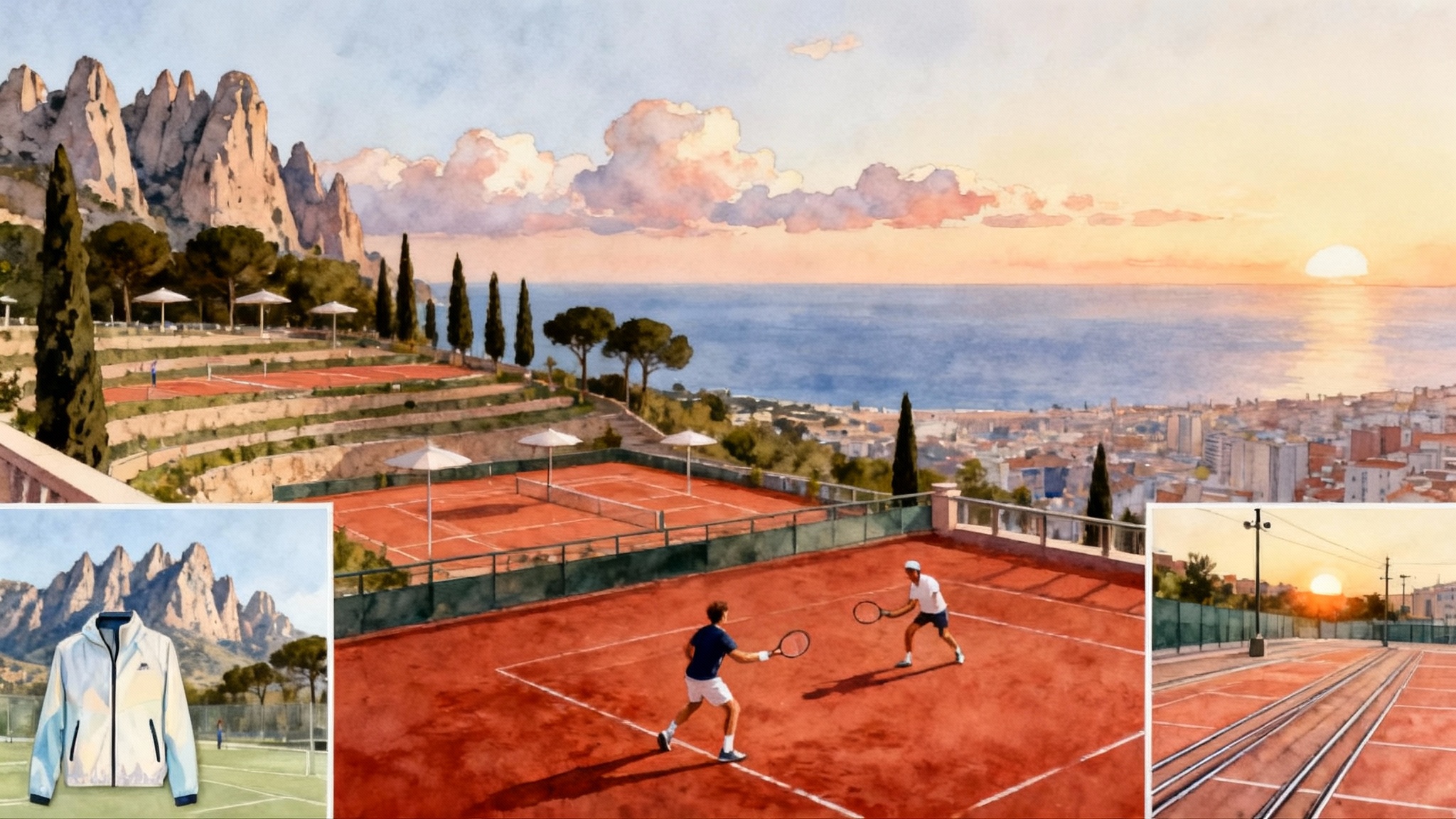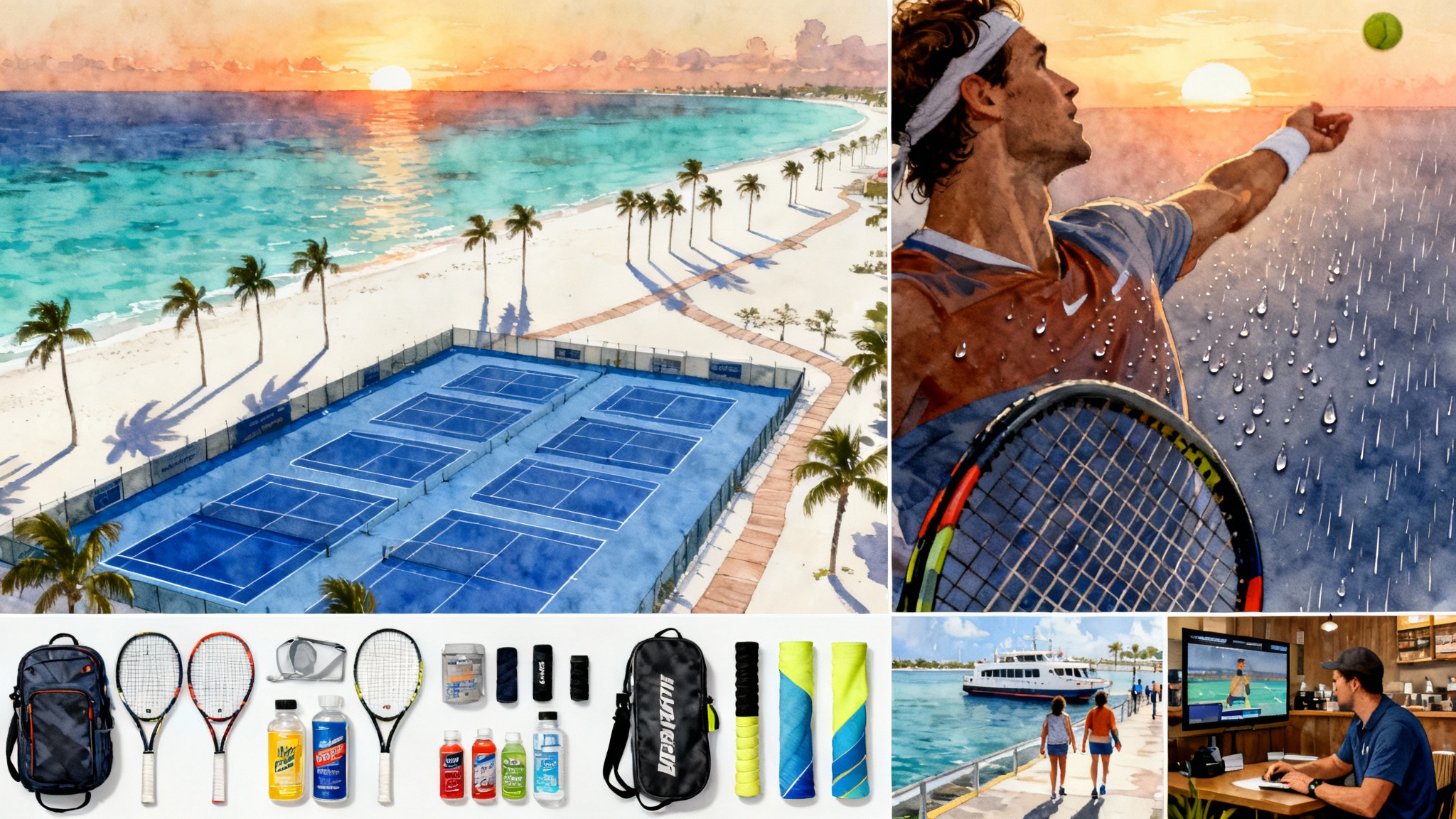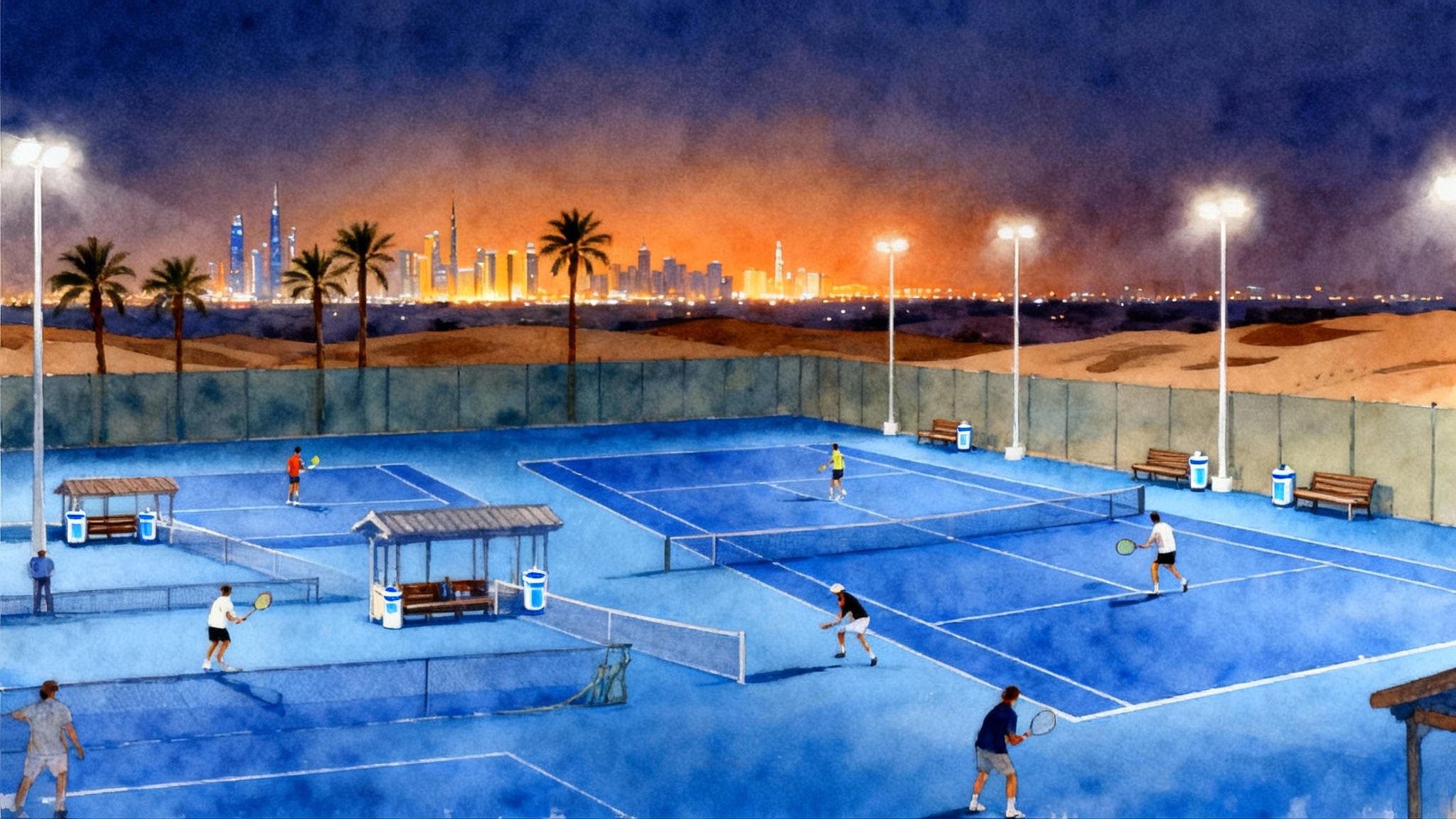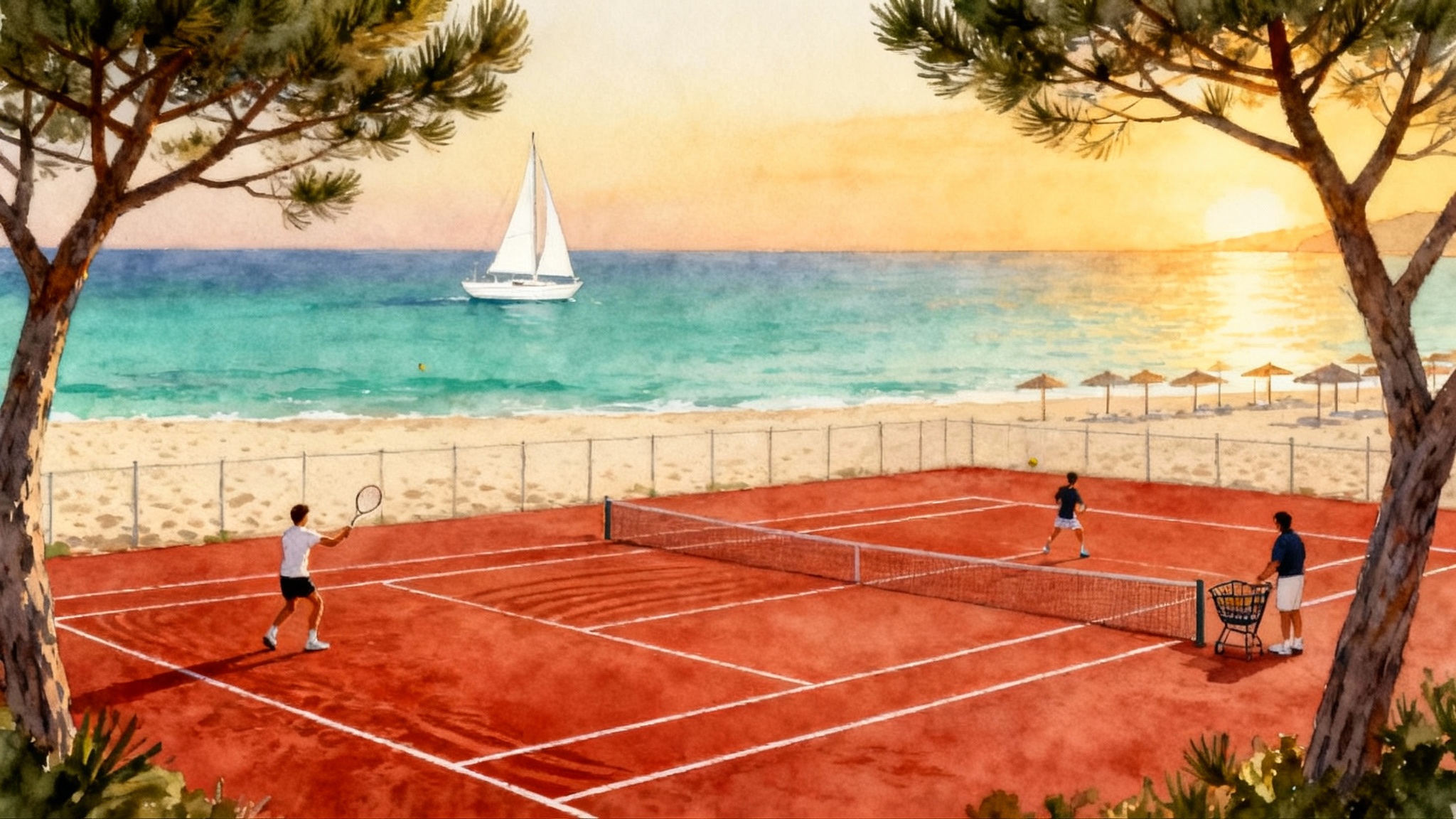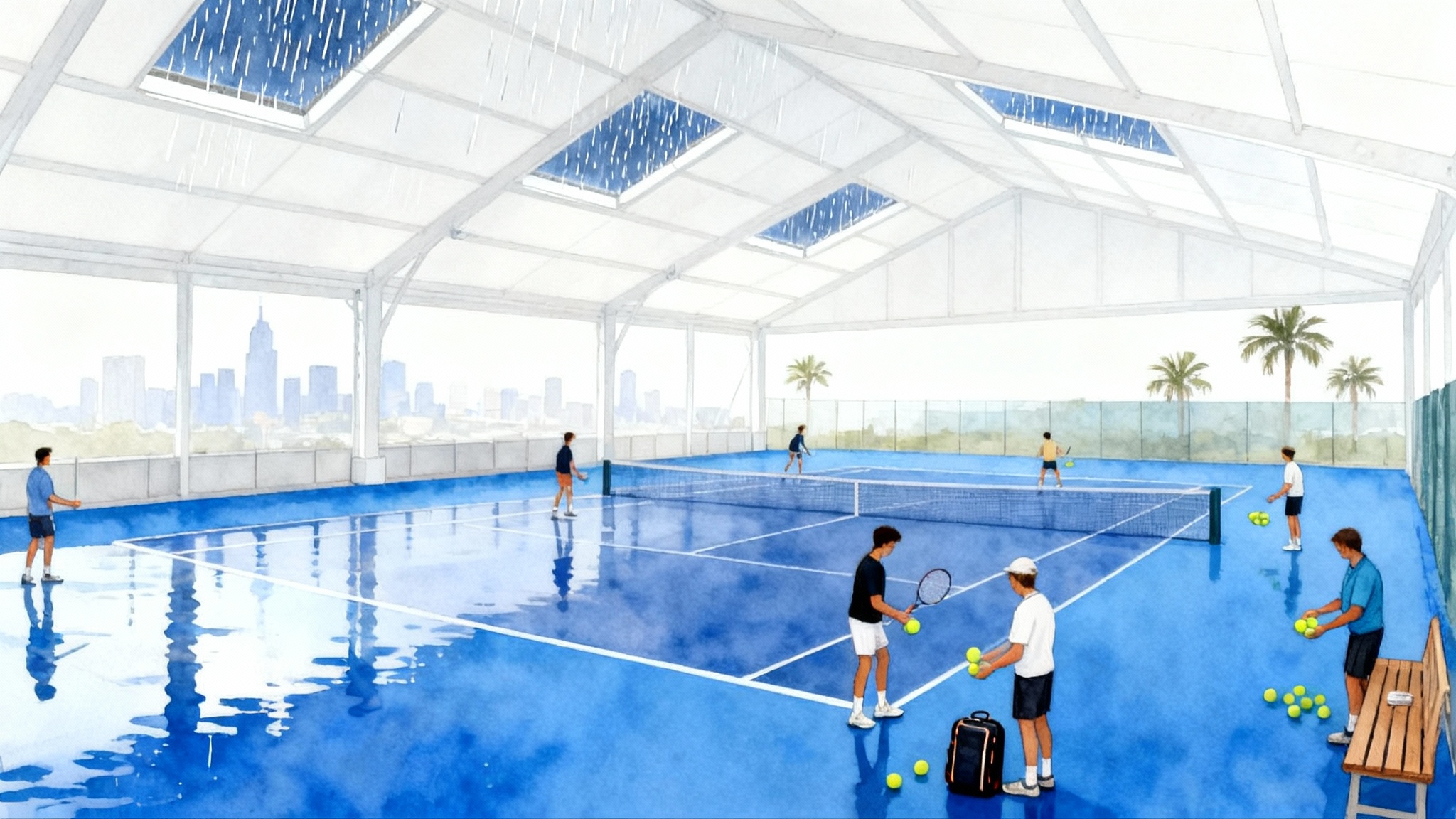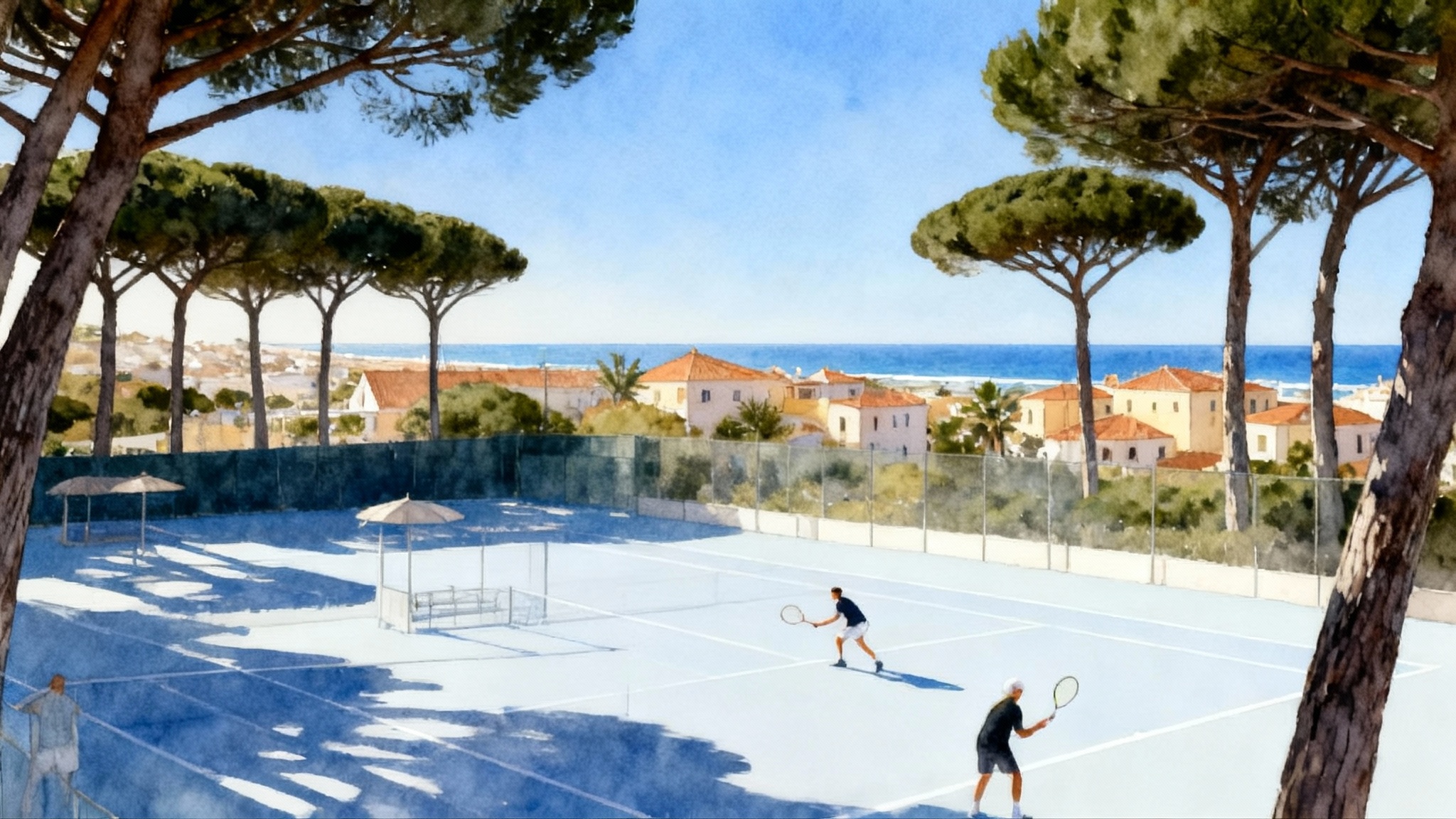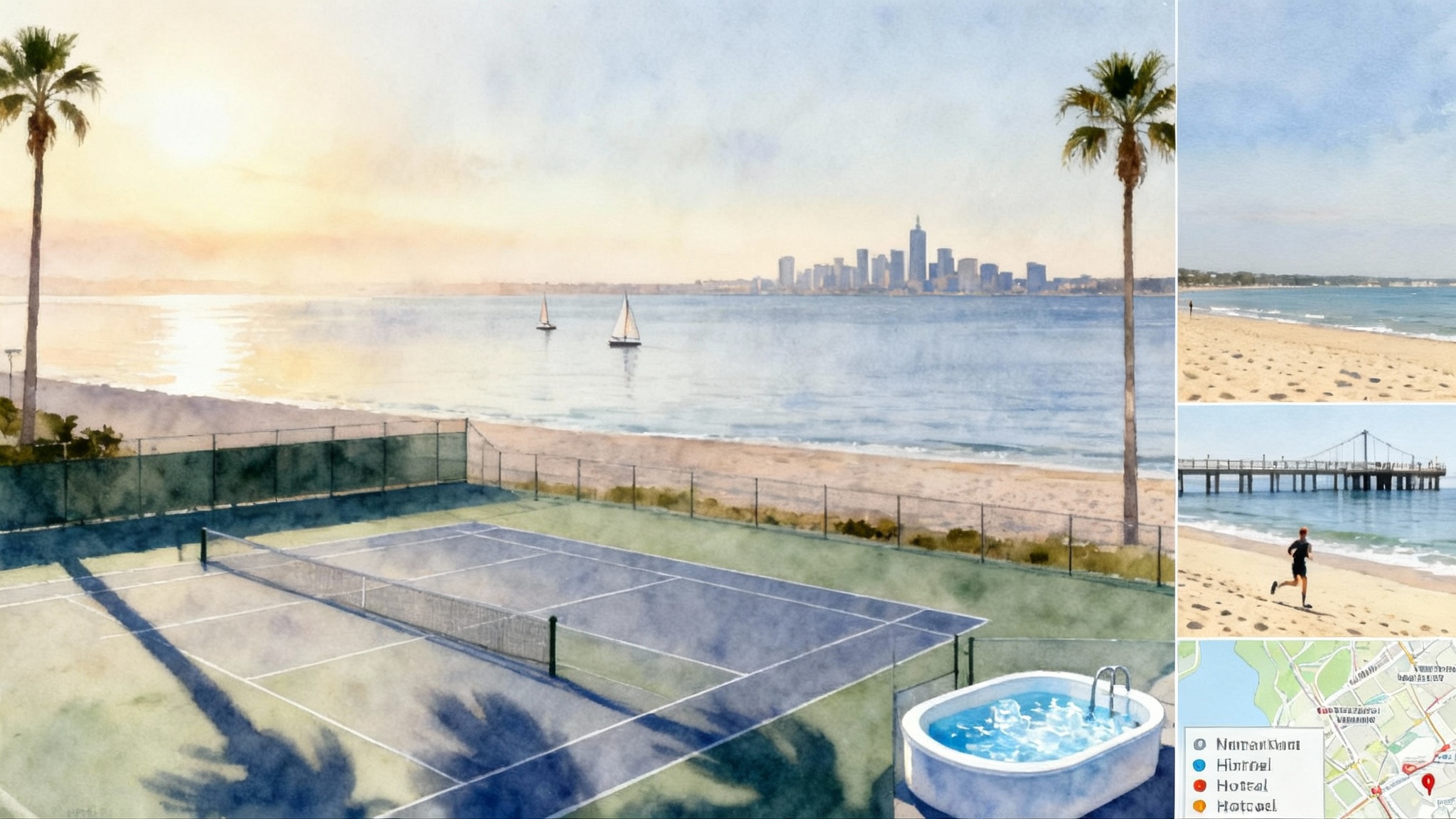Algarve Tennis 2025–26: Pine Cliffs, Vilamoura, Lagos Guide
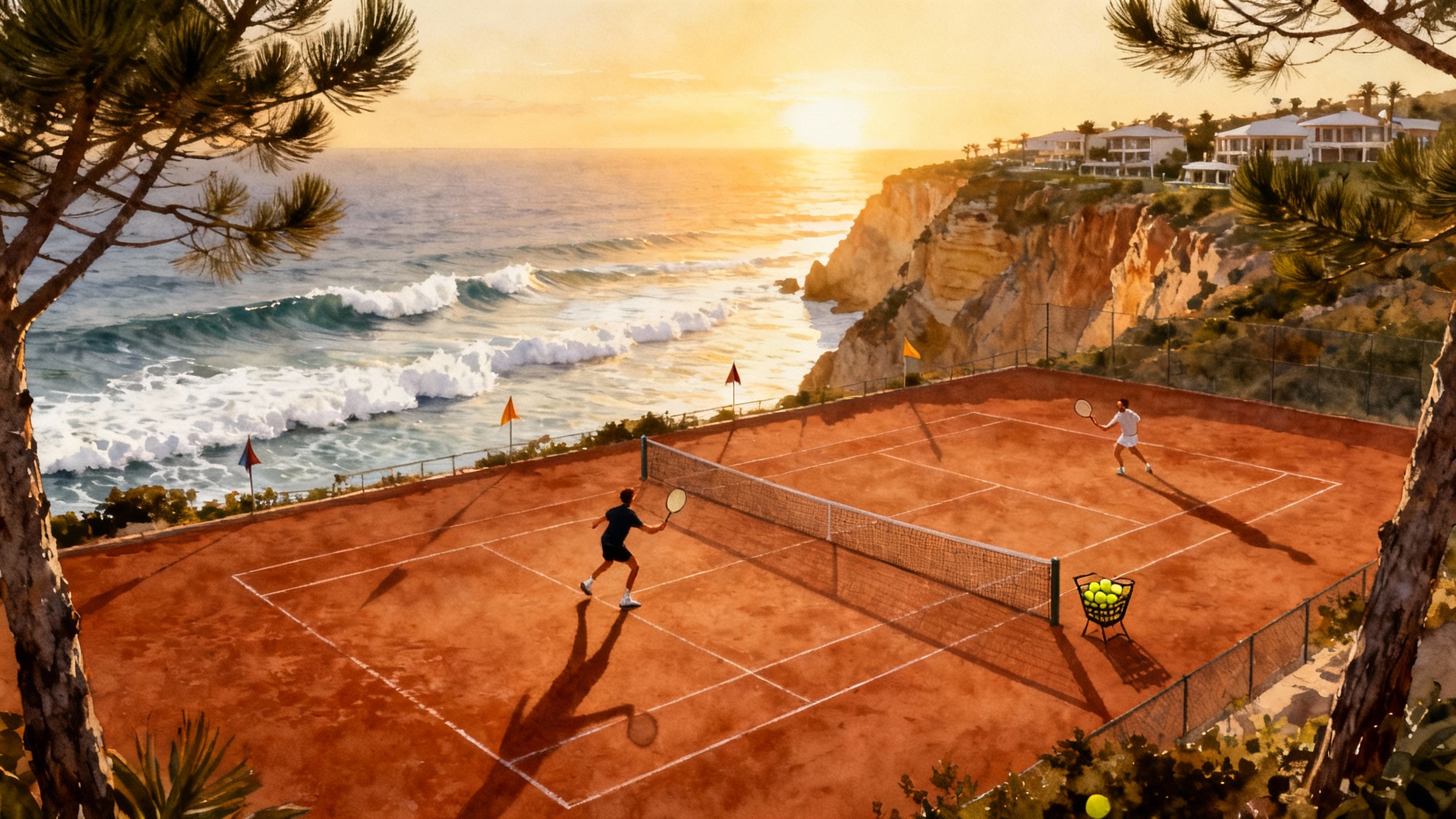
Why the Algarve from October to May
If you want a European base where you can train through fall, winter, and spring without losing outdoor time, the Algarve checks the right boxes. The temperatures are mild, daylight is generous compared with much of the United States in winter, and the coast offers a dense cluster of courts and clubs within a short drive. The shoulder season rhythm is simple and effective: skill work in the fresh morning air, match play once the day warms, and recovery by the ocean. If you are weighing other dependable bases, compare coastal clay options in our Barcelona coast clay guide or the desert consistency in Dubai winter tennis.
This guide lays out a complete training week for October through May that starts most days at Annabel Croft Tennis Academy at Pine Cliffs, then shifts to competitive sets at local clubs in Vilamoura or Lagos. You will learn how to adjust for coastal wind and sun, how to pick between clay and hard, and how to make Lisbon to Faro travel painless.
What the shoulder season feels like
- Temperatures: Expect highs around 60 to 75 degrees Fahrenheit from October to May, coolest in December to February and rising by April. Early mornings can start in the low 50s, so pack a light layer for warm-ups.
- Wind: Afternoons can be breezy on exposed courts. A steady onshore or northwesterly breeze is common, lighter in the early morning and strongest mid to late afternoon. Plan your heaviest technique work before lunch and expect point construction and serve practice with wind later in the day.
- UV and light: Even in winter the sun can be sharp, especially on light-colored courts. UV is moderate in midwinter and climbs quickly by April and May. Sunglasses with a secure fit, a brimmed hat, and broad-spectrum sunscreen are not optional.
- Rain: The wettest stretch is November through February. Showers are usually short. Build one flexible day into your plan so a weather blip does not derail your week.
Surfaces and where to find them
You can play both hard and clay in the Algarve. Many resort courts are cushioned or acrylic hard. Several clubs offer red clay, which drains well after rain and plays truer than artificial surfaces in wind. If your goal is college-style or U.S. hard-court match fitness, keep at least half of your hitting on hard. If you are tuning movement and patience for clay events, make two of your afternoon sessions on red clay.
- Pine Cliffs area: Pine Cliffs sits on the coast between Albufeira and Vilamoura and hosts Annabel Croft Tennis Academy. Courts are sheltered by pines which helps with wind. Morning clinics here set the technical tone for the day. For on-site details and program style, read our Annabel Croft Tennis Academy profile.
- Vilamoura clubs: Vilamoura is a short drive from Pine Cliffs and has a dense network of courts, friendly club ladders, and seasonal hitters. You can usually find red clay and hard within the same zip code.
- Lagos and the west: Lagos offers relaxed clubs with a strong expat community. Surfaces vary by club week to week, but set play is easy to arrange and afternoons here tend to be sunnier and slightly windier than sheltered resorts.
The two-session model that works
Training quality rises when you separate precision from pressure. In the Algarve that means technique and patterning in the morning, then competitive sets after lunch.
- Morning block: Footwork patterns, serve plus one, returns, and first-strike drills. Keep the work deep, heavy, and repeatable. This is where you reinforce a shape on the ball and a reliable first serve.
- Afternoon block: Sets and tiebreakers. Lean into the elements. Use the wind to practice depth and margin. Mix surfaces during the week so you build patience on clay and decisiveness on hard.
Mornings at Annabel Croft Tennis Academy
Annabel Croft Tennis Academy at Pine Cliffs offers structured clinics and private sessions that are dialed for shoulder-season travelers. Check the current clinic schedule and private lesson options on the academy’s official page: Annabel Croft Tennis Academy at Pine Cliffs. Book morning slots so you finish by noon and protect your technical work from wind.
What to request when you book:
- Serve patterns that hold up in wind: targets, spins, and second-serve shape
- Backhand depth under pressure, with cross to down-the-line change-ups
- Short-ball management on both surfaces
- Point-start sequences: serve plus two, return plus two
Afternoons of match play at local clubs
After lunch, shift to Vilamoura or Lagos for sets. Most clubs can match you with locals or seasonal players, especially if you reach out the day prior. Tell the desk your level and whether you want hard or clay. If you come with a small group, book two adjacent courts and rotate short sets to six with a 10-point tiebreak.
Match-play formats that fit a windy coast:
- Crosswind cage: play crosscourt-only to 11, then add line changes to finish
- Second-serve sets: second serve only, to build trust in spin
- Big-point ladder: play regular scoring but add a sudden-death point at 2-all, 4-all, and 5-all games
Recovery by design
- Movement: 10 minutes of hip and thoracic spine mobility before every afternoon hit
- Strength: two 30-minute micro-sessions per week with split squats, hinges, and anti-rotation
- Cardio: one beach jog on firm sand or a steady 30-minute bike on a non-court day
- Sleep: shoulder season is quiet. Use it. Lights out by 10:30 p.m. will do more for your week than one extra set.
Sample week for juniors (ages 12 to 18)
This plan assumes a base near Pine Cliffs and a car. Adjust times for daylight in December to January.
-
Monday
- 8:00–9:15 a.m. Dynamic warm-up, footwork ladders, heavy crosscourts
- 9:15–10:15 a.m. Serve plus one patterns, first-ball depth
- 10:15–11:00 a.m. Returns, especially second-serve attacks
- 3:00–5:00 p.m. Two short sets to six on hard, tiebreaks to 10
-
Tuesday
- 8:00–10:00 a.m. Private lesson on backhand shape, add approach-and-finish
- 3:00–5:00 p.m. Clay sets in Vilamoura, angle defense and height over net
-
Wednesday
- 8:30–10:30 a.m. Pattern rehearsal, cross to down-the-line change
- Afternoon off: beach walk, homework, mobility work
-
Thursday
- 8:00–10:00 a.m. Serve day: targets, second-serve spin, body serve
- 3:00–5:00 p.m. Team ladder in Lagos, one set each with super tiebreak finishers
-
Friday
- 8:30–10:30 a.m. Returns and neutral tolerance drills
- 3:00–5:00 p.m. Mixed-surface match play depending on availability
-
Saturday
- 9:00–11:00 a.m. Match simulation: two full sets, coaching only on changeovers
- Afternoon sightseeing or recovery swim
-
Sunday
- Flexible weather buffer. If the week was dry, take a full rest day.
Focus cue for juniors: On clay, value height and shape before pace. On hard, value first-strike clarity before rally length.
Sample week for adult players
This plan balances development and enjoyment.
-
Monday
- 8:30–10:00 a.m. Clinic focused on consistency and depth
- 3:30–5:00 p.m. Doubles on hard, work return placement and first volley
-
Tuesday
- 8:30–10:00 a.m. Serve and return workshop, finish with 15-minute tiebreakers
- 3:30–5:00 p.m. Singles on clay, long-point tolerance
-
Wednesday
- 9:00–10:30 a.m. Private lesson on backhand and transition
- Afternoon off: coastal walk and stretch
-
Thursday
- 8:30–10:00 a.m. Forehand heavy-ball clinic
- 3:30–5:00 p.m. Doubles on clay, lobs and overheads in wind
-
Friday
- 8:30–10:00 a.m. Point construction with serve plus one
- 3:30–5:00 p.m. Singles on hard, two sets
-
Saturday
- 9:00–11:00 a.m. Friendly round robin, prizes for most returns made
- Evening early dinner, pack for travel
-
Sunday
- Travel or open day. If staying, book a late morning hit and a recovery swim.
Adult focus cue: Keep the second serve honest. On windy days add more spin and aim bigger targets.
Logistics from the United States
Getting there
- Fly to Lisbon for the widest options from the United States. From Lisbon you can connect to Faro, drive south, or take the train.
- Faro airport is the closest to Pine Cliffs, Vilamoura, and Lagos. Car rentals at Faro are affordable in the shoulder season and save time if you plan to visit multiple clubs.
Train and car
If you do not want to drive, take the train from Lisbon’s Oriente station to the Algarve. The fastest services take roughly two and a half to three hours to Albufeira-Ferreiras or Loulé. Schedules and tickets are available through Comboios de Portugal timetable search. From those stations, it is a short taxi or rideshare to Pine Cliffs or Vilamoura.
If you drive from Lisbon, plan for about two and a half hours on major toll roads. Most rentals support an electronic toll device billed to your card. Fuel stops and food options are frequent along the route.
Where to base
- Pine Cliffs area: Best for morning clinics and sheltered courts, easy reach to Albufeira, Vilamoura, and Loulé.
- Vilamoura: Dense club scene, marina restaurants, and quick access to multiple surfaces.
- Lagos: Laid-back vibe, good afternoon sun, and scenic rest-day options along the cliffs and beaches.
Approximate drive times in normal traffic:
- Faro airport to Pine Cliffs: about 35 minutes
- Pine Cliffs to Vilamoura: 15 to 25 minutes
- Pine Cliffs to Lagos: 55 to 70 minutes
Budget tiers you can plan around
Prices vary by month and availability. These ranges reflect typical shoulder-season costs and help you plan a realistic week.
-
Lean and focused
- Lodging: 70 to 120 United States dollars per night for a simple apartment near Albufeira or Vilamoura
- Car rental: 15 to 30 dollars per day, plus tolls and fuel
- Courts: 12 to 25 euros per hour at local clubs
- Group clinics: 25 to 45 euros per session
- Private lessons: 80 to 130 euros per hour
- Food: 25 to 45 dollars per person per day with self-catering and simple meals
-
Smart midrange
- Lodging: 140 to 220 dollars per night for a resort apartment or midrange hotel near Pine Cliffs
- Car rental: compact automatic with toll device
- Mix of three group clinics and two private lessons for the week, plus four match-play sessions
- Food: 45 to 70 dollars per person per day
-
Indulgent performance week
- Lodging: 250 to 450 dollars per night for a full-service resort near the courts
- Driver or rideshare instead of a rental car
- Daily private coaching plus reserved clay and hard sessions
- Sports massage once or twice during the week
- Food: 70 to 120 dollars per person per day, including marina dinners
Budget tips:
- Bring your own balls for the first two days. Local shops have stock, but brands and felt types vary.
- String locally only if you confirm machine type and string options. Otherwise pre-string two racquets with slightly different tensions for wind and clay.
- Book afternoon courts one day ahead. Mornings are easier to find, afternoons can cluster.
Clay versus hard: how to split your week
- Goal is hard-court sharpness: 60 percent hard, 40 percent clay. Emphasize serve plus one, return plus one, and front-foot forehands. Finish rallies with depth rather than line-painting.
- Goal is clay patience and legs: 60 percent clay, 40 percent hard. Emphasize height, spin, and pattern discipline. Build one break per set and protect it.
Simple drills that translate between surfaces:
- Three-ball sequence: neutral, neutral, offense. You must earn offense with depth or height.
- Inside-out cage: play inside-out forehands crosscourt only to 11, then open the line for the last three points.
- Return ladder: five deep middle returns in a row before aiming corners.
The wind and sun toolkit
- Strings and tension: go two pounds tighter on very windy days to keep trajectories stable. On clay, keep your spin setup and aim a little higher over the net.
- Ball choice: heavier felt helps on blustery days. On clay, accept a slightly slower ball and build points with width.
- Serve shapes: kick serves into the wind, body serves with crosswinds, slice serves going with the breeze to pull the return off court.
- Positioning: on the downwind baseline, start half a step deeper. Upwind, take a step inside the baseline to take time away.
- Sun tactics: if one service end has glare, choose to return there first so you serve from the clearer end at 1-all.
What to pack
- Racquets: two matched frames, one strung two pounds tighter
- Strings: one extra set of your main and one set of a softer cross
- Balls: one to two sleeves to start your week
- Hat and sunglasses: secure fit, dark under-brim for glare
- Sunscreen: reef-safe, broad-spectrum, and a travel-size zinc stick for nose and ears
- Layers: a light quarter-zip for cool mornings and a thin rain shell for passing showers
- Small physio kit: bands, lacrosse ball, and travel roller
Booking checklist and timing
- Two to four weeks out: reserve morning clinics at Pine Cliffs and hold a few private lesson slots. If traveling in school holidays, book earlier.
- One to two weeks out: email or call Vilamoura and Lagos clubs to request afternoon match play. Share your level and preferred surfaces.
- Two days out: confirm courts, string racquets, and map drive times. Decide which day will be your weather buffer.
- Night before: check wind direction and speed. Set your serve plan accordingly.
How a day flows when it all clicks
- 7:00 a.m. Coffee, 10-minute mobility, snack
- 8:00 a.m. Annabel Croft session: footwork, serve plus one, returns
- 11:30 a.m. Early lunch, hydration, 20-minute rest
- 1:30 p.m. Drive to club, dynamic warm-up
- 2:00–4:00 p.m. Two sets on clay or hard with format goals
- 4:00–4:15 p.m. Breath work and light stretch
- Evening. Walk a cliff path or beach, simple dinner, lights out before 10:30 p.m.
A note on culture and recovery
You are in a region that rewards a slower pace. Let that help your tennis. Walk to dinner. Pick grilled fish, vegetables, and olive oil. Sleep well. The shoulder season is quiet enough that you can treat the entire trip as a recovery block around your twice-daily sessions.
The final word
The Algarve’s shoulder season invites a simple, repeatable training week: technical mornings in the pines at Pine Cliffs, competitive afternoons in Vilamoura or Lagos, and ocean air to tie it together. Plan for wind and sun, split your time between clay and hard based on your goals, and build one buffer day so weather never gets a vote. Travel is straightforward through Lisbon to Faro, costs are predictable if you decide your tier early, and the court density means you can find the right ball every day. Do this right and you will fly home with cleaner patterns, better match fitness, and a coastline you will want to revisit as soon as the next shoulder season begins.
